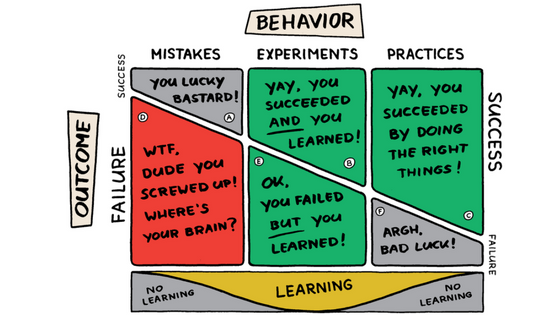Celebration Grid – A Versatile Team Tool

To Avoid Successful Failure
From an instructor’s perspective, I find the Celebration Grid by far the most fascinating tool in the Management 3.0 toolkit. I first learnt about celebration grids as they came up during a keynote that Management 3.0 thinker and practitioner Jurgen Appelo gave at the Mile High Agile convention in Denver, Colorado in 2016. In his talk, Appelo explained how he created the celebration grid as a visual representation of ideas outlined in Donald G. Reinertsen’s (2009) book – The principles of product development flow. Reinertsens’s book is notoriously dry and complicated, so I very much appreciated Appelo’s visualisation of it.
In short, a celebration grid makes it very easy for managers to identify and discuss behaviours versus outcomes and success versus failure. Personally, I use the tool to reflect on group activities. As you can see in the illustration above this post, the grid is divided into three columns: Mistakes, Experiments and Practises, and three rows: Success, Failure and Learning. As for the colour coding, green and red obviously mean success and failure, grey is kind of neutral and yellow represents learning.
The Practises column is the most straightforward, if you do the right things the right way, you’ll likely be successful. Sadly enough, even the best tried-and-tested practises fail every now and then. But this is not necessarily a reflection on the team that failed. As long as they reflect on what happened, they will learn and avoid failure in the future. One example of a best practice that might fail is the use of checklists. The thinking behind checklists is hard to argue against as a good checklist breaks down a complicated procedure into a series of logical, easy to follow, steps. But what if something happens that isn’t covered by the checklist? Everything we do and use today is far more complex than it used to be, so unless checklists are continually evaluated and updated, they might end up doing more harm than good.
More interesting I find the Mistakes column. Mistakes tend to lead to failure, but sometimes something gone wrong can actually lead to success. And as long as we reflect on and try to understand our failures, we will learn from them and possibly be successful at a later time. A well-known example of this is the Post-it Note. Back in 1968, a 3M research scientist attempted to create a super strong glue, but he failed. Then in 1974, one of his colleagues found that the failed glue had an interesting characteristic, a strip of paper with the unglue swiped onto its edges could be stuck on any surface and stay in place. When not needed anymore, it could be easily removed without any harm done. The idea of an improved bookmark was born and Post-it Notes rapidly became the top-selling office-supply they are today.
The most interesting column to me is Experiments. As you can see in the graph, both success and failure are green (i.e. successful). Why? Basically, experimenting means trying something new without knowing if the outcome will be a success or not. Either you try and succeed or you try and fail. But whatever the outcome, you always learn something new, or, as Thomas Edison once remarked:
“[You] haven’t failed you’ve just found 10,000 ways that don’t work.”
In his book Managing for Happiness, Appelo (2016) makes a strong case for, what he calls, experimental learning by claiming that an organisation needs both success and failure to learn (information theorists hold that systems learn best with a failure rate of 50%). And in today’s Creative Economy, organisations need to learn all the time! This is the true strength of the celebration grid, it allows managers to celebrate learning rather than uninspired success or successful failures. If this all sounds a bit too abstract, watch the short video below in which Appelo gives his own take on the topic:
Our experience with the Celebration Grid
At the Wu-Wei Research Institute, we run rather successful Lunch & Learn “Lasagne Challenge” Workshops. At these workshops, a diverse group of participants is divided into small teams, each of which is given an element (e.g. pasta, red sauce, white sauce etc.) to make for the lasagne we aim to have for lunch. As they only have a recipe, the ingredients and limited time, this often turns into quite a chaotic event (we’ve learnt to always have a backup lunch ready in case of total disaster). After lunch, we use Appelo’s celebration grid to evaluate the activity and identify what has been learnt from it.
I find that the participants’ reaction to the tool is almost always very positive. It really helps them visualise and reflect on what happened and they like the focus on learning over failure. When our team evaluates the workshops, we also use the grid and start our meetings with, what Appelo coined, the two Yay! Questions: What did we do well? and What did we learn? I like this because it emphasises the positive, thus creating space for the things that didn’t go well later on. Also, it encourages creativity and a drive to experiment within our team. We are an experiential learning organisation and so any tool that helps us be more experimental will benefit both us and our clients. As I mentioned at the start of this article, for us the Celebration Grid is by far the most fascinating tool in the Management 3.0 toolkit.
Author: Marko van Gaans from https://wuwei-inst.org/management-3-0-celebration-grids/
Resources:
Appelo, J. (2016). Yay! Questions and Celebration Grids in Managing for Happiness (pp. 235-250). Hoboken, NJ: John Wiley & Sons.
Reinertsen, D. (2009). The principles of product development flow (1st ed.). Redondo Beach, CA: Celeritas.
Post-It Note Origin. (2011). Snopes.com. Retrieved 2 September 2017, from http://www.snopes.com/business/origins/post-it.asp
Appelo, J. (2015). Celebration Grids: Celebrate Learning. (video) Retrieved 28 July 2017, from Youtube: https://youtu.be/MNkTgMUQGDE




